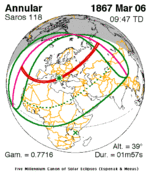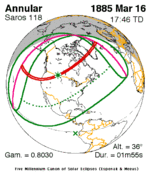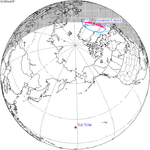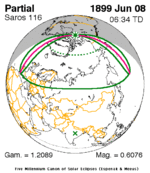Solar eclipse of April 30, 1957
An annular solar eclipse occurred at the Moon's descending node of orbit on Tuesday, April 30, 1957,[1] with a magnitude of 0.9799. A solar eclipse occurs when the Moon passes between Earth and the Sun, thereby totally or partly obscuring the image of the Sun for a viewer on Earth. An annular solar eclipse occurs when the Moon's apparent diameter is smaller than the Sun's, blocking most of the Sun's light and causing the Sun to look like an annulus (ring). An annular eclipse appears as a partial eclipse over a region of the Earth thousands of kilometres wide. Occurring about 6.1 days after apogee (on April 23, 1957, at 22:20 UTC), the Moon's apparent diameter was smaller.[2]
It will be unusual in that while it is a total solar eclipse, it is not a central solar eclipse. A non-central eclipse is one where the center-line of totality does not intersect the surface of the Earth (when the gamma is between 0.9972 and 1.0260). Instead, the center line passes just above the Earth's surface. This rare type occurs when totality is only visible at sunset or sunrise in a polar region.
Annularity was visible from northern Soviet Union (today's Russia) and Bear Island, the southernmost island of Svalbard, Norway. A partial eclipse was visible for parts of East Asia, Northeast Asia, Alaska, Canada, and the Northwestern United States. This was the last of 57 umbral eclipses in Solar Saros 118.
Eclipse details
Shown below are two tables displaying details about this particular solar eclipse. The first table outlines times at which the moon's penumbra or umbra attains the specific parameter, and the second table describes various other parameters pertaining to this eclipse.[3]
| Event | Time (UTC) |
|---|---|
| First Penumbral External Contact | 1957 April 29 at 21:50:57.6 UTC |
| First Umbral External Contact | 1957 April 29 at 23:51:50.2 UTC |
| Ecliptic Conjunction | 1957 April 29 at 23:54:18.0 UTC |
| Greatest Eclipse | 1957 April 30 at 00:05:27.8 UTC |
| Last Umbral External Contact | 1957 April 30 at 00:18:44.0 UTC |
| Equatorial Conjunction | 1957 April 30 at 00:31:13.8 UTC |
| Last Penumbral External Contact | 1957 April 30 at 02:19:40.2 UTC |
| Parameter | Value |
|---|---|
| Eclipse Magnitude | 0.97988 |
| Eclipse Obscuration | - |
| Gamma | 0.99918 |
| Sun Right Ascension | 02h27m57.4s |
| Sun Declination | +14°37'21.8" |
| Sun Semi-Diameter | 15'52.5" |
| Sun Equatorial Horizontal Parallax | 08.7" |
| Moon Right Ascension | 02h27m05.4s |
| Moon Declination | +15°32'09.0" |
| Moon Semi-Diameter | 15'22.0" |
| Moon Equatorial Horizontal Parallax | 0°56'23.9" |
| ΔT | 31.8 s |
Eclipse season
This eclipse is part of an eclipse season, a period, roughly every six months, when eclipses occur. Only two (or occasionally three) eclipse seasons occur each year, and each season lasts about 35 days and repeats just short of six months (173 days) later; thus two full eclipse seasons always occur each year. Either two or three eclipses happen each eclipse season. In the sequence below, each eclipse is separated by a fortnight.
| April 30 Descending node (new moon) | May 13 Ascending node (full moon) |
|---|---|
 |  |
| Annular solar eclipse Solar Saros 118 | Total lunar eclipse Lunar Saros 130 |
Related eclipses
Eclipses in 1957
- An annular solar eclipse on April 30.
- A total lunar eclipse on May 13.
- A total solar eclipse on October 23.
- A total lunar eclipse on November 7.
Metonic
- Preceded by: Solar eclipse of July 11, 1953
- Followed by: Solar eclipse of February 15, 1961
Tzolkinex
- Preceded by: Solar eclipse of March 18, 1950
- Followed by: Solar eclipse of June 10, 1964
Half-Saros
- Preceded by: Lunar eclipse of April 23, 1948
- Followed by: Lunar eclipse of May 4, 1966
Tritos
- Preceded by: Solar eclipse of May 30, 1946
- Followed by: Solar eclipse of March 28, 1968
Solar Saros 118
- Preceded by: Solar eclipse of April 19, 1939
- Followed by: Solar eclipse of May 11, 1975
Inex
- Preceded by: Solar eclipse of May 19, 1928
- Followed by: Solar eclipse of April 9, 1986
Triad
- Preceded by: Solar eclipse of June 28, 1870
- Followed by: Solar eclipse of February 28, 2044
Solar eclipses of 1957–1960
This eclipse is a member of a semester series. An eclipse in a semester series of solar eclipses repeats approximately every 177 days and 4 hours (a semester) at alternating nodes of the Moon's orbit.[4]
| Solar eclipse series sets from 1957 to 1960 | ||||||
|---|---|---|---|---|---|---|
| Descending node | Ascending node | |||||
| Saros | Map | Gamma | Saros | Map | Gamma | |
| 118 | April 30, 1957 Annular (non-central) | 0.9992 | 123 | October 23, 1957 Total (non-central) | 1.0022 | |
| 128 | April 19, 1958 Annular | 0.275 | 133 | October 12, 1958 Total | −0.2951 | |
| 138 | April 8, 1959 Annular | −0.4546 | 143 | October 2, 1959 Total | 0.4207 | |
| 148 | March 27, 1960 Partial | −1.1537 | 153 | September 20, 1960 Partial | 1.2057 | |
Saros 118
This eclipse is a part of Saros series 118, repeating every 18 years, 11 days, and containing 72 events. The series started with a partial solar eclipse on May 24, 803 AD. It contains total eclipses from August 19, 947 AD through October 25, 1650; hybrid eclipses on November 4, 1668 and November 15, 1686; and annular eclipses from November 27, 1704 through April 30, 1957. The series ends at member 72 as a partial eclipse on July 15, 2083. Its eclipses are tabulated in three columns; every third eclipse in the same column is one exeligmos apart, so they all cast shadows over approximately the same parts of the Earth.
The longest duration of totality was produced by member 34 at 6 minutes, 59 seconds on May 16, 1398, and the longest duration of annularity was produced by member 59 at 1 minutes, 58 seconds on February 23, 1849. All eclipses in this series occur at the Moon’s descending node of orbit.[5]
| Series members 57–72 occur between 1801 and 2083: | ||
|---|---|---|
| 57 | 58 | 59 |
 February 1, 1813 |  February 12, 1831 |  February 23, 1849 |
| 60 | 61 | 62 |
 March 6, 1867 |  March 16, 1885 |  March 29, 1903 |
| 63 | 64 | 65 |
 April 8, 1921 |  April 19, 1939 |  April 30, 1957 |
| 66 | 67 | 68 |
 May 11, 1975 |  May 21, 1993 |  June 1, 2011 |
| 69 | 70 | 71 |
 June 12, 2029 |  June 23, 2047 |  July 3, 2065 |
| 72 | ||
 July 15, 2083 | ||
Metonic series
The metonic series repeats eclipses every 19 years (6939.69 days), lasting about 5 cycles. Eclipses occur in nearly the same calendar date. In addition, the octon subseries repeats 1/5 of that or every 3.8 years (1387.94 days). All eclipses in this table occur at the Moon's descending node.
| 21 eclipse events between July 11, 1953 and July 11, 2029 | ||||
|---|---|---|---|---|
| July 10–11 | April 29–30 | February 15–16 | December 4 | September 21–23 |
| 116 | 118 | 120 | 122 | 124 |
 July 11, 1953 |  April 30, 1957 |  February 15, 1961 |  December 4, 1964 |  September 22, 1968 |
| 126 | 128 | 130 | 132 | 134 |
 July 10, 1972 |  April 29, 1976 |  February 16, 1980 |  December 4, 1983 |  September 23, 1987 |
| 136 | 138 | 140 | 142 | 144 |
 July 11, 1991 |  April 29, 1995 |  February 16, 1999 |  December 4, 2002 |  September 22, 2006 |
| 146 | 148 | 150 | 152 | 154 |
 July 11, 2010 |  April 29, 2014 |  February 15, 2018 |  December 4, 2021 |  September 21, 2025 |
| 156 | ||||
 July 11, 2029 | ||||
Tritos series
This eclipse is a part of a tritos cycle, repeating at alternating nodes every 135 synodic months (≈ 3986.63 days, or 11 years minus 1 month). Their appearance and longitude are irregular due to a lack of synchronization with the anomalistic month (period of perigee), but groupings of 3 tritos cycles (≈ 33 years minus 3 months) come close (≈ 434.044 anomalistic months), so eclipses are similar in these groupings.
| Series members between 1837 and 2200 | ||||
|---|---|---|---|---|
 April 5, 1837 (Saros 107) |  March 5, 1848 (Saros 108) |  February 3, 1859 (Saros 109) |  December 2, 1880 (Saros 111) | |
 August 31, 1913 (Saros 114) |  July 31, 1924 (Saros 115) |  June 30, 1935 (Saros 116) | ||
 May 30, 1946 (Saros 117) |  April 30, 1957 (Saros 118) |  March 28, 1968 (Saros 119) |  February 26, 1979 (Saros 120) |  January 26, 1990 (Saros 121) |
 December 25, 2000 (Saros 122) |  November 25, 2011 (Saros 123) |  October 25, 2022 (Saros 124) |  September 23, 2033 (Saros 125) |  August 23, 2044 (Saros 126) |
 July 24, 2055 (Saros 127) |  June 22, 2066 (Saros 128) |  May 22, 2077 (Saros 129) |  April 21, 2088 (Saros 130) |  March 21, 2099 (Saros 131) |
 February 18, 2110 (Saros 132) |  January 19, 2121 (Saros 133) |  December 19, 2131 (Saros 134) |  November 17, 2142 (Saros 135) |  October 17, 2153 (Saros 136) |
 September 16, 2164 (Saros 137) |  August 16, 2175 (Saros 138) |  July 16, 2186 (Saros 139) |  June 15, 2197 (Saros 140) | |
Inex series
This eclipse is a part of the long period inex cycle, repeating at alternating nodes, every 358 synodic months (≈ 10,571.95 days, or 29 years minus 20 days). Their appearance and longitude are irregular due to a lack of synchronization with the anomalistic month (period of perigee). However, groupings of 3 inex cycles (≈ 87 years minus 2 months) comes close (≈ 1,151.02 anomalistic months), so eclipses are similar in these groupings.
| Series members between 1801 and 2200 | ||
|---|---|---|
 August 7, 1812 (Saros 113) |  July 18, 1841 (Saros 114) |  June 28, 1870 (Saros 115) |
 June 8, 1899 (Saros 116) |  May 19, 1928 (Saros 117) |  April 30, 1957 (Saros 118) |
 April 9, 1986 (Saros 119) |  March 20, 2015 (Saros 120) |  February 28, 2044 (Saros 121) |
 February 7, 2073 (Saros 122) |  January 19, 2102 (Saros 123) |  December 30, 2130 (Saros 124) |
 December 9, 2159 (Saros 125) |  November 18, 2188 (Saros 126) | |
Notes
- ^ "April 29–30, 1957 Annular Solar Eclipse". timeanddate. Retrieved 6 August 2024.
- ^ "Moon Distances for London, United Kingdom, England". timeanddate. Retrieved 6 August 2024.
- ^ "Annular Solar Eclipse of 1957 Apr 30". EclipseWise.com. Retrieved 6 August 2024.
- ^ van Gent, R.H. "Solar- and Lunar-Eclipse Predictions from Antiquity to the Present". A Catalogue of Eclipse Cycles. Utrecht University. Retrieved 6 October 2018.
- ^ "NASA - Catalog of Solar Eclipses of Saros 118". eclipse.gsfc.nasa.gov.
References
- Earth visibility chart and eclipse statistics Eclipse Predictions by Fred Espenak, NASA/GSFC
- Google interactive map
- Besselian elements
- v
- t
- e
| By era | |
|---|---|
| Saros series (list) | |
| Visibility | |
| Historical |
|

Total/hybrid eclipses
→ next total/hybrid
- 1133
- 1185
- 1560
- 1598
- 1652
- 1654
- 1673
- 1706
- 1715
- 1724
- 1766
- 1778
- 1780
- 1806
- 1816
- 1824
- 1842
- 1851
- 1853
- 1857
- 1858
- 1860
- 1865
- 1867
- 1868
- 1869
- 1870
- 1871
- 1874
- 1875
- 1878
- 1882
- 1883
- 1885
- 1886
- 1887
- Jan. 1889
- Dec. 1889
- 1893
- 1896
- 1898
- 1900
- 1901
- 1903
- 1904
- 1905
- 1907
- Jan. 1908
- Dec. 1908
- 1909
- 1910
- 1911
- Apr. 1912
- Oct. 1912
- 1914
- 1916
- 1918
- 1919
- 1921
- 1922
- 1923
- 1925
- 1926
- 1927
- 1928
- 1929
- Apr. 1930
- Oct. 1930
- 1932
- 1934
- 1936
- 1937
- 1938
- 1939
- 1940
- 1941
- 1943
- Jan. 1944
- 1945
- 1947
- 1948
- 1950
- 1952
- 1954
- 1955
- 1956
- 1957
- 1958
- 1959
- 1961
- 1962
- 1963
- 1965
- 1966
- 1967
- 1968
- 1970
- 1972
- 1973
- 1974
- 1976
- 1977
- 1979
- 1980
- 1981
- 1983
- 1984
- 1985
- 1986
- 1987
- 1988
- 1990
- 1991
- 1992
- 1994
- 1995
- 1997
- 1998
- 1999
- 2001
- 2002
- 2003
- 2005
- 2006
- 2008
- 2009
- 2010
- 2012
- 2013
- 2015
- 2016
- 2017
- 2019
- 2020
- 2021
- 2023
- 2024
- → 2026
- 2027
- 2028
- 2030
- 2031
- 2033
- 2034
- 2035
- 2037
- 2038
- 2039
- 2041
- 2042
- 2043
- 2044
- 2045
- 2046
- 2048
- 2049
- 2050
- 2052
- 2053
- 2055
- Jan. 2057
- Dec. 2057
- 2059
- 2060
- 2061
- 2063
- 2064
- 2066
- 2067
- 2068
- 2070
- 2071
- 2072
- 2073
- 2075
- 2076
- 2077
- 2078
- 2079
- 2081
- 2082
- 2084
- 2086
- 2088
- 2089
- 2090
- 2091
- 2093
- 2094
- 2095
- 2096
- 2097
- 2099
- 2100
- 2186

Annular eclipses
→ next annular
- 1820
- 1854
- 1879
- 1889
- 1900
- 1901
- 1903
- 1904
- 1905
- 1907
- 1908
- 1911
- 1914
- Feb. 1915
- Aug. 1915
- 1916
- 1917
- 1918
- 1919
- 1921
- 1922
- 1923
- 1925
- 1926
- 1927
- 1929
- 1932
- Feb. 1933
- Aug. 1933
- 1934
- 1935
- 1936
- 1937
- 1939
- 1940
- 1941
- 1943
- Jul. 1944
- 1945
- 1947
- 1948
- 1950
- Mar. 1951
- Sep. 1951
- 1952
- Jan. 1954
- Dec. 1954
- 1955
- 1957
- 1958
- 1959
- 1961
- 1962
- 1963
- 1965
- 1966
- Mar. 1969
- Sep. 1969
- 1970
- 1972
- Jan. 1973
- Dec. 1973
- 1976
- 1977
- 1979
- 1980
- 1981
- 1983
- 1984
- 1987
- 1988
- 1990
- 1991
- 1992
- 1994
- 1995
- 1998
- 1999
- 2001
- 2002
- 2003
- 2005
- 2006
- 2008
- 2009
- 2010
- 2012
- 2013
- 2014
- 2016
- 2017
- 2019
- 2020
- 2021
- 2023
- → 2024
- 2026
- 2027
- 2028
- 2030
- 2031
- 2032
- 2034
- 2035
- 2036
- Jan. 2038
- Jul. 2038
- 2039
- 2041
- 2042
- 2043
- 2044
- 2045
- 2046
- 2048
- 2049
- 2052
- 2053
- Jan. 2056
- Jul. 2056
- 2057
- 2059
- 2060
- 2061
- 2063
- 2064
- 2066
- 2067
- 2070
- 2071
- Jan. 2074
- Jul. 2074
- 2075
- 2077
- 2078
- 2079
- 2081
- 2082
- 2084
- Jun. 2085
- Dec. 2085
- 2088
- 2089
- Feb. 2092
- Aug. 2092
- 2093
- 2095
- 2096
- 2097
- 2099
- 2100

Partial eclipses
→ next partial
- Jan. 1639
- Apr. 1902
- May 1902
- Oct. 1902
- Feb. 1906
- Jul. 1906
- Aug. 1906
- Dec. 1909
- Nov. 1910
- Apr. 1913
- Aug. 1913
- Sep. 1913
- Dec. 1916
- Jan. 1917
- Jun. 1917
- Jul. 1917
- May 1920
- Nov. 1920
- Mar. 1924
- Jul. 1924
- Aug. 1924
- Dec. 1927
- Jun. 1928
- Nov. 1928
- Apr. 1931
- Sep. 1931
- Oct. 1931
- Jan. 1935
- Feb. 1935
- Jun. 1935
- Jul. 1935
- Nov. 1938
- Mar. 1942
- Aug. 1942
- Sep. 1942
- Jan. 1946
- May 1946
- Jun. 1946
- Nov. 1946
- Apr. 1949
- Oct. 1949
- Feb. 1953
- Jul. 1953
- Aug. 1953
- Dec. 1956
- Mar. 1960
- Sep. 1960
- Jan. 1964
- Jun. 1964
- Jul. 1964
- Dec. 1964
- May 1967
- Mar. 1968
- Feb. 1971
- Jul. 1971
- Aug. 1971
- Dec. 1974
- May 1975
- Nov. 1975
- Apr. 1978
- Oct. 1978
- Jan. 1982
- Jun. 1982
- Jul. 1982
- Dec. 1982
- May 1985
- Apr. 1986
- Mar. 1989
- Aug. 1989
- Dec. 1992
- May 1993
- Nov. 1993
- Apr. 1996
- Oct. 1996
- Sep. 1997
- Feb. 2000
- 1 Jul. 2000
- 31 Jul. 2000
- Dec. 2000
- Apr. 2004
- Oct. 2004
- Mar. 2007
- Sep. 2007
- Jan. 2011
- Jun. 2011
- Jul. 2011
- Nov. 2011
- Oct. 2014
- Sep. 2015
- Feb. 2018
- Jul. 2018
- Aug. 2018
- Jan. 2019
- Apr. 2022
- Oct. 2022
- → Mar. 2025
- Sep. 2025
- Jan. 2029
- Jun. 2029
- Jul. 2029
- Dec. 2029
- 2032
- 2033
- Feb. 2036
- Jul. 2036
- Aug. 2036
- 2037
- May 2040
- Nov. 2040
- Jan. 2047
- Jun. 2047
- Jul. 2047
- Dec. 2047
- 2050
- Apr. 2051
- Oct. 2051
- Mar. 2054
- Aug. 2054
- Sep. 2054
- 2055
- May 2058
- Jun. 2058
- Nov. 2058
- Mar. 2062
- Sep. 2062
- Feb. 2065
- Jul. 2065
- Aug. 2065
- Dec. 2065
- 2068
- Apr. 2069
- May 2069
- Oct. 2069
- 2072
- 2073
- Jun. 2076
- Jul. 2076
- Nov. 2076
- Feb. 2083
- Jul. 2083
- Aug. 2083
- 2084
- 2086
- May 2087
- Jun. 2087
- Oct. 2087
- 2090
- 2091
- Jun. 2094
- Jul. 2094
- Dec. 2094
- Apr. 2098
- Sep. 2098
- Oct. 2098
 Astronomy portal
Astronomy portal Solar System portal
Solar System portal Category
Category













